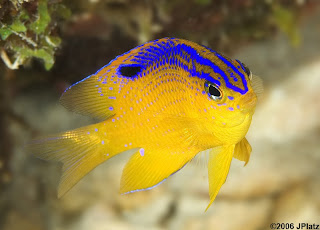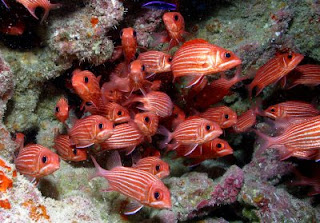Another colorful and abundant reef fish is the damselfish, a delicate-looking animal with a small mouth. Damselfish nibble on the encrusting algae that grow on coral and rock. These red, yellow, orange, or blue fish grow to be about 6 inches (15 cm) long.
 |
| Damselfish |
Like most damselfish, the Pacific gregory (Stegastes fasciolatus) is active during the day. Most of this fish’s time is spent “farming” a patch of alga that may cover up to 10.7 square feet (1 sq. m) of the reef. An excellent gardener, the little damselfish weeds out unwanted corals and algae so that its favored algae can flourish. To supplement plant growth, the fish fertilizes its garden with its own feces.
 |
| Stegastes fasciolatus |
One of the brightest and best-known reef fish is the percula clown fish (Amphiprion ocellaris), one of several species of clown fishes and a member of the damselfish family. Reaching only 2.4 inches (6 cm), this small animal is striped in orange, white, and black. The percula clown fish lives in the tentacles of several kinds of anemones, despite the latter’s deadly stinging cells. Anemone tentacles are covered with mucus that prevents one tentacle from stinging another. The clown fish coats its body with this same mucus, a process that takes about one hour. If the clown fish and anemone are separated, the fish loses its immunity and has to repeat the procedure.
.jpg) |
| Amphiprion ocellaris (clown fish) |
From its safe haven among the tentacles, a clown fish can cautiously dart out to feed on plankton and small crustaceans. The female percula clown fish lays her eggs on rock or coral near the anemone. After the male fertilizes them, both parents guard the clutch until the eggs hatch, running back to their safe house when threatened.
Squirrelfish, such as those in the lower color insert on page C-6, are colorful animals whose large populations make them conspicuous on many reefs. Sabre squirrelfish (Sargocentron spiniferum) are one of the larger species, growing to lengths of 17.7 inches (45 cm). Squirrelfish are numerous, but their populations are rivaled by the cardinal fish. During the day, cardinals hide in the crevices, but at night these fish, which average about 4 inches (10.2 cm) long, cover the reef. Many are red, a color that looks black in dark water and helps them avoid predators. Like other fish that are active at night, cardinal fish have very big eyes.
 |
| Squirrelfish |
During the reproductive cycle, cardinal fish employ a very unusual technique of guarding their eggs called mouth brooding. After eggs are laid in the water and fertilized, the male takes them in his mouth and keeps them there until they hatch. During this period of incubation, the male fish does not eat. Even after hatching, the young may return to hide in the father’s mouth for short periods of time.
 |
| Cardinal fish |
The cardinal fish is just one of several kinds of fish that are difficult to spot in the water. Many reef fish are well camouflaged, an adaptation that offers two big advantages: It helps animals avoid their predators, and it makes it easier for predators to ambush their own prey. The longlure frogfish (Antennarius multiocellatus) is so highly camouflaged that it looks like one of the corals or sponges. When the longlure frogfish moves from one location to another, it changes its colors so that wherever it goes it blends in perfectly. To attract prey, the fish is equipped with a fleshy antenna that dangles in front of its head similar to a fishing lure dangling from a pole. By waiting quietly with its antenna poised, the frogfish attracts small fish that mistake the lure for a snack. If a fish happens to bite off the lure, it grows back.
 |
| Antennarius multiocellatus (frogfish) |


.jpg)



